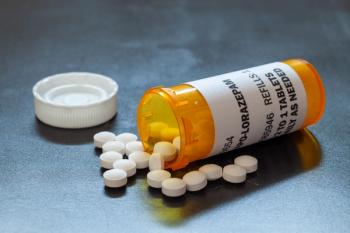
Clinical Overview: Innovations in Nephrology 2023
It is important for pharmacists to understand implications related to drug clearance to maximize therapeutics in patients with kidney disease.
End-stage kidney disease (ESKD) is a devastating disease associated with high morbidity and mortality. The prevalence of ESKD increased by 118.7% from 2000-2019, and accounted for $37.3 billion in Medicare spending in 2019.1
Although kidney transplantation is the preferred method of ESKD treatment for most patients, only 3.1% received a kidney transplant as their initial ESKD therapy in 2020.2 More than 550,000 patients received a modality of dialysis for ESKD treatment during this period.2 While there are legislative, professional, and patient advocacy organization-backed efforts underway to improve transplantation rates, there is a need for continued innovation in the dialysis treatment space.
In addition to improving higher transplantation rates, there is an emphasis on increasing the proportion of dialysis patients who receive their treatment at home. The Advancing American Kidney Health initiative established a goal to have 80% of new ESKD patients receive home dialysis or a transplant by 2025.3
Peritoneal dialysis (PD) is the most common modality of dialysis received at home, representing 15% of all dialysis starts in 2020.2 One of the biggest barriers to greater uptake is concern about the risk of peritonitis.4
Peritonitis carries a high relapse rate, is associated with an increased risk of death, and leads to a permanent transfer from PD to hemodialysis in 18% of patients.5 Innovations aimed at reducing the risk of peritonitis could improve the utilization of and outcomes associated with PD.
The National Kidney Foundation recently announced an investment from its Innovation Fund in Relavo to aid its further development in its PeritoneX technology.6 PeritoneX is an in-line connection device that aims to internally disinfect dialysis tubes at all connection sites in the PD system.7
The device uses 0.55% sodium hypochlorite flushed into the PD connection space via a vacuum mechanism to disinfect the connection tube ends.8 PeritoneX is compatible with existing PD systems and laboratory data show a greater than 5-log reduction against a spectrum of bacteria associated with peritonitis.6
Innovations are also occurring in the manner that patients may receive kidney replacement therapy. Although the risk of infection represents a significant barrier to uptake, particularly for home PD, the size of the equipment itself along with the physical strength required to lift and exchange the dialysate fluid can also represent an obstacle with both forms of home dialysis.4
Moreover, the discontinuous nature of dialysis leaves patients with inter-dialytic accumulation of fluids, electrolytes, and toxins; a far cry from the function of the native organ.9 For these reasons, work toward a portable, continuous, artificial kidney is an area in need of great innovation.
In 2014, Nissenson outlined criteria for a theoretically ideal bio-engineered kidney, including being small enough to wear or implant, being resistant to displacement, dislodgment, thrombosis, or biofilm formation, and utilizing small dialysate volumes plus an inbuilt dialysis regeneration circuit.10
Two innovations are moving toward this functional artificial kidney model, the first of which, designed for HD, is aptly named the wearable artificial kidney (WAK).11 The WAK 2.0 model, an 11-pound, battery-powered device, utilizes a dialysate regeneration sorbent technology.
Micropumps control ultrafiltration, along with heparin, calcium acetate, magnesium acetate, and sodium bicarbonate infusions into the dialysate circuit. It is a closed-looped system and the regeneration process allows for a small volume of dialysate fluid (i.e., 375 ml).
A small safety trial in 7 patients, of whom 5 completed the full 24-hour study treatment duration, found the WAK 2.0 to be well tolerated with effective uremic solute clearance and fluid removal. However, the trial was stopped early secondary to device-related technical problems, including excessive carbon dioxide bubbles in the dialysate circuit and variable blood and dialysate flows.
The newer WAK 3.0 version, weighing only 2 lbs. and with a rechargeable battery, sought to better the shortcoming of its predecessor and was recently granted a patent approval.12 Upcoming studies in patients will evaluate the ultimate viability of this updated model.
The second device in clinical trials, the automated wearable artificial kidney in PD (AWAK-PD); a 4-lbs. purse-sized wearable.13 Similar to the WAK, the AWAK-PD utilizes sorbent technology to continuously recycle the spent dialysate allowing for an initial fill volume of only 0.9 to 2L.
The battery-powered pump passes dialysate through the adsorber system to remove uremic toxins, then mixes the fluid with fresh dialysate, calcium, magnesium, and glucose before returning to the patient. The infusate reservoir and adsorber system are contained within a disposable cartridge that performs 7 hours of therapy.
A recent pilot study conducted in 15 patients for a maximum of 72 hours of therapy evaluating the tolerability and efficacy of dialysis related to the removal of serum urea, creatinine, phosphate, and β2-microglobulin resulted in significant reductions in all serum markers of effectiveness. No patients experienced any serious adverse events, although 60% reported abdominal pain or discomfort.
As with the WAK studies, there were some observed technical issues, most notably as it relates to net ultrafiltration (i.e., excess fluid absorption). While neither the WAK or AWAK-PD devices are ready for full clinical deployment, the innovation behind these devices is unmistakable and the prospect of a true wearable artificial kidney may not be so far away. When that day arrives, it will be important for us, as pharmacists, to understand implications related to drug clearance to maximize therapeutics in this already vulnerable population.
The access catheters that are the conduit for HD procedures are a lifeline and, simultaneously, a hazard, stemming from associated complications, including catheter-related bloodstream infections (CRBSI). Despite Fistula First initiatives aimed at patients initiating HD though a mature arteriovenous fistula (AVF), the 2022 United States Renal Data System noted approximately 80% of patients initiated HD via a central venous catheter (HD-CVC).14
Subsequently, an HD-CVC will remain the mainstay access for some 20% of patients and approximately 40% of those who do or will ultimately transition to AVF or arteriovenous graft (AVG) still required a catheter by 1 year of HD initiation.14 The risk of bacteremia and sepsis when these HD-CVCs are in place ranges from 2- to-5-fold higher than seen with AVF or AVG.15
Bloodstream infection (BSI) rates tabulated through the 2019 NHSN Dialysis Event Surveillance Report show though HD-CVCs represent only 20% of reported patient months, 63% of BSIs occurred in those with catheters.16 The median time to CRBSI ranges from about 2-3 month from insertion, with ~50% occurring within 90 days.17,18 Given these data and acknowledging the CRBSI-associated mortality and morbidity, reducing risk of BSI while the HD-CVC is in place is a vital practice consideration.
Taurolidine/heparin (previously known as Neutrolin), an investigational drug product, is a non-antibiotic antibacterial and antifungal catheter-lock solution (CLS) being developed by CorMedix for the prevention CRBSIs in patients with ESKD.19,20 The mechanism of action of taurolidine and its metabolites is broad-spectrum, causing damage to microbial cell walls and inhibiting adherence of microorganisms to biological surfaces, thus affecting the viability of the microorganisms themselves as well as mitigating biofilm formation on the HD-CVC surface.21 The CLS is meant to be instilled in both the arterial and venous lumens and ports of the HD-CVC and remain within until aspirated prior to the next HD session.
The efficacy and safety of this CLS was evaluated in the LOCK IT-100 trial, a phase 3, 1:1 randomized, double-blind, active-controlled, phase 3 clinical study designed to evaluate taurolidine/heparin versus a heparin control for the prevention of CRBSI in patients with ESRD receiving hemodialysis via an HD-CVC.21 The primary endpoint was time to clinically adjudicated CRBSI, with secondary endpoints of catheter removal for any reason and loss of catheter patency.21,22
Taurolidine/heparin instilled in the HD-CVC lumens at the end of each HD session demonstrated a 71% risk reduction in CRBSI versus heparin alone. There were no significant differences between treatment arms in time to catheter removal for any reason or loss of catheter patency. The safety of taurolidine/heparin CLS was comparable to heparin, and most treatment-emergent adverse events were mild or moderate.22,23 This product will undergo FDA review in 2023.
The burden of kidney disease continues to grow, as does the dialysis-dependent kidney disease population. Though dialysis serves to replace native kidney function, prolong survival and, in some ways, allow patients to maintain their daily lives, navigating the facets of, and related complications from, these dialysis procedures is an encumbrance to patients, caregivers, and health care providers alike.
As solutions come forward with the goal of providing alternatives that accommodate patient needs or options to allay collateral damage associated with PD and HD, an awareness and proactive assessment of the implications from the perspective of pharmacy practitioners is key. As exampled with these products highlighted are the aspects of pharmacokinetic considerations that can translate to appropriate, safe, and effective dosing of medications and infection prevention that can affect overall antimicrobial exposure and the collateral effects thereof, which are both basic tenets of pharmacy practice.
References
- Burrows NR, Koyama A, Pavkov ME. "Reported cases of end-stage kidney disease—United States, 2000–2019." Am J Transplant. 2022; 22:1483-1486.
- United States Renal Data System. 2022 USRDS annual data report: End Stage Renal Disease. Bethesda, MD: National Institutes of Health, National Institute of Diabetes and Digestive and Kidney Diseases; 2022. Accessed February 23, 2023.
https://usrds-adr.niddk.nih.gov/2022 - Mehrotra, R. "Advancing American kidney health: an introduction." Clin J Am Soc Nephrol. 2019;14(12):1788.
- Morton RL, Snelling P, Webster AC, et al. Dialysis modality preference of patients with CKD and family caregivers: a discrete-choice study. Am J Kidney Dis. 2012;60(1):102-11.
- Mehrotra R, Devuyst O, Davies SJ, Johnson DW. The current state of peritoneal dialysis. J Am Soc Nephrol. 2016;27(11):3238-3252.
- National Kidney Foundation. NKF Innovation Fund Invests in Relavo to improve home dialysis. Accessed February 23, 2023.
https://www.kidney.org/news/nkf-innovation-fund-announces-investment-relavo-peritonex-r-technology-to-improve-health-equity . - Relavo, Inc. Relavo: Bringing Safety to Home Dialysis. Accessed February 23, 2023.
https://relavomedical.com/ . - The James Dyson Foundation. Relavo: Peritoneal Dialysis Infection Prevention. Accessed February 23, 2023
https://www.jamesdysonaward.org/en-US/2019/project/relavo-peritoneal-dialysis-infection-prevention/ . - Jena R, Aggarwal A, Choudhary GR, Bajpai NK. Current Status and Future of Artificial Kidney in Humans. Indian J Nephrol. 2022;32(6):531-538.
- Nissenson AR. Improving outcomes for ESRD patients: Shifting the quality paradigm. Clin J Am Soc Nephrol. 2014;9(2):430-4.
- Gura V, Rivara MB, Bieber S, et al. A wearable artificial kidney for patients with end-stage renal disease. JCI Insight. 2016;1(8):e86397.
- Healio Nephrology.US issues patent for wearable artificial kidney. Accessed February 23, 2023.
https://www.healio.com/news/nephrology/20210511/us-issues-patent-for-wearable-artificial-kidney . - Htay H, Gow SK, Jayaballa M, et al. Preliminary safety study of the Automated Wearable Artificial Kidney (AWAK) in Peritoneal Dialysis patients. Perit Dial Int. 2022;42(4):394-402.
- 2022 United States Renal Data System Annual Data Report. End Stage Renal Disease: Incidence, Prevalence, Patient Characteristics, and Treatment Modalities. Accessed February 27, 2023.
https://usrds-adr.niddk.nih.gov/2022/end-stage-renal-disease/1-incidence-prevalence-patient-characteristics-and-treatment-modalities - Lok C, Mokrzycki MH. Prevention and management of catheter-related infection in hemodialysis patients. Kidney International. 2011;79:587–598.
- 2019 Surveillance Summary of Bloodstream Infections in Outpatient Hemodialysis Facilities (2014-2019). National Healthcare Safety Network. Accessed February 27, 2023.
https://www.cdc.gov/dialysis/pdfs/BSI-NHSN-2014to2019-508.pdf - Massey K, Roxanna Seyedin, Krithika Rajagopalan. Rapid Incidence and Emergence of Catheter-Related Blood Stream Infections Among CVC-Dependent HD Patients. Poster presented at: American Society of Nephrology Kidney Week 2022; November 3-6, 2022; Orlando, FL.
- Massey K, Roxanna Seyedin, Krithika Rajagopalan. Mortality Risk and Long-term Complications Associated with Catheter-Related Bloodstream Infections (CRBSIs). Poster presented at: American Society of Health-System Pharmacists Midyear Clinical Meeting and Exhibition; December 3-8, 2022; Las Vegas, NV.
- Gong L, Greenberg HE, Perhach JL, et al. The Pharmacokinetics of Taurolidine Metabolites in Healthy Volunteers. J Clin Pharmacol 2007;47:697-703.
- Caruso F, Darnowski JW, Opazo C, et al. Taurolidine Antiadhesive Properties on Interaction with E. coli; Its Transformation in Biological Environment and Interaction with Bacteria Cell Wall. PLoS One. 2010;5(1):e8927
- Study Assessing Safety & Effectiveness of a Catheter Lock Solution in Dialysis Patients to Prevent Bloodstream Infection. ClinicalTrials.gov identifier NCT02651428. Updated August 31, 2021. Accessed February 23, 2023.
Study Assessing Safety & Effectiveness of a Catheter Lock Solution in Dialysis Patients to Prevent Bloodstream Infection - Full Text View - ClinicalTrials.gov - CorMedix, Inc. Media and Publication: Press release. Updated January 30, 2919. Accessed February 27, 2023.
https://www.cormedix.com/cormedix-inc-announces-topline-analysis-full-data-set-phase-3-lock-100-study-reinforces-interim-results/ - LOCK-IT-100: A Phase III, Prospective, Multicenter, Double-Blind, Randomized, Active Control Study to Demonstrate the Safety and Effectiveness of Neutrolin® in Preventing Catheter-Related Bloodstream Infections in Subjects Receiving Hemodialysis Therapy as Treatment for End Stage Renal Disease. Presented at: National Kidney Foundation Spring Clinical Meeting. May 8-12, 2019; Boston, MA.
https://www.cormedix.com/wp-content/uploads/2019/05/LOCK-IT-100-NKF-Presentation-As-Presented-10-May-2019.pdf
Newsletter
Stay informed on drug updates, treatment guidelines, and pharmacy practice trends—subscribe to Pharmacy Times for weekly clinical insights.




















































































































































































































